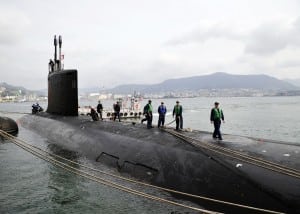The House Armed Services Committee (HASC) has moved to restore funding in its version of the next defense policy bill for the continued development of a nuclear-tipped sea-launched cruise missile, reversing the Navy’s proposal to cancel the program.
The panel adopted an amendment by voice vote during its markup of the fiscal year 2023 National Defense Authorization Act (NDAA), which was still ongoing as of Defense Daily
’s deadline, authorizing $45 million in research and development funding for the weapon, with lawmakers arguing it keeps the option open to field such a system in the future.

“The R&D money, it’s only $45 million, is indispensable to keeping the program warm, to keeping that option available,” Rep. Jim Cooper (D-Tenn.), chair of the HASC Strategic Forces Subcommittee, said in support of the amendment. “No one can tell in an uncertain world what we will need. But it’s important to keep this option open and available.”
Cooper, who co-sponsored the measure with Rep. Doug Lamborn (R-Colo.), the Strategic Forces ranking member, noted that the chairman and vice chairman of the Joint Chiefs of Staff, the head of U.S. Strategic Command and Chief of Naval Operations Adm. Mike Gilday have all testified that “we need to have the option to have [SLCM-N] in future years.”
Rep. Adam Smith (D-Wash.), the HASC chair, opposed the measure, while adding he appreciates it doesn’t commit the Navy to fielding the system.
“So the people who are in the Navy, who operate attack submarines, understand the impact that this is going to have on their ability to do what attack submarines do…don’t want this. So this is a compromise not to commit to it but to give us the option going forward. I still don’t support it but it’s a reasonable compromise off of what was being proposed before that,” Smith said.
The Navy has said the proposal to cancel SLCM-N in the budget request was due to cost concerns and a view that the program could not be built on time, citing that move would save about $200 million in fiscal year 2023 and more than $2 billion over the next five years (Defense Daily, April 18).
For funding, the amendment authorizes $25 million for Navy R&D to further SLCM-N development and $20 million to the National Nuclear Security Administration (NNSA) to work on the weapon’s warhead.
Cooper’s amendment, more specifically, calls for reports from the Navy Secretary on the full cost of developing, producing, fielding and maintaining SLCM-N and describing “any operational limitations and trade-offs that would be associated with deploying” the system, according to a copy of the measure.
The amendment also calls for the head of the NNSA to submit a report to Congress on the cost and timeline of developing the SLCM-N warhead, and whether this schedule would impact efforts to work on other planned warhead activities.
More broadly, Cooper’s measure directs the Secretary of Defense to also submit a report to Congress describing the Pentagon’s approach “for deterring theater nuclear employment by Russia and China.”
Rep. Rob Wittman (R-Va.), ranking member of the HASC Seapower and Projection Forces Subcommittee, said having a capability like SLCM-N may be a key piece to ensuring deterrence with adversaries such as China and Russia.
“It’s incredibly important for us to have an equal response capability in order to deter our adversaries. When the only response in our arsenal to the deployment of a low-yield nuclear weapon is a high-yield nuclear weapon, that takes options off the table for us. And I would argue it actually emboldens and, potentially, provokes confrontation a near-peer adversary,” Wittman said.